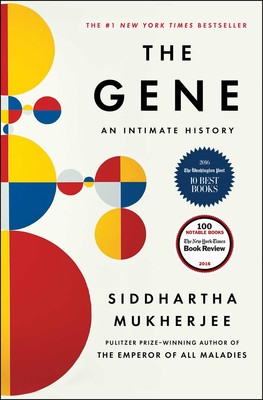“The Gene’”-—a new documentary presented by acclaimed filmmaker Ken Burns—weaves together science, history & personal stories for a historical biography of the human genome, while also exploring breakthroughs for diagnosis & treatment of genetic diseases & the complex ethical questions they raise. The two-night premiere of “The Gene” will air on April 7th and 14th at 8/7c on PBS. To learn more about the best-selling book that inspired the documentary, read this special selection from Dr. Siddhartha Mukherjee’s “The Gene: An Intimate History,” available now from CBS sister company Simon & Schuster.
[The Gene: An Intimate History] is the story of the birth, growth, and future of one of the most powerful and dangerous ideas in the history of science: the “gene,” the fundamental unit of heredity, and the basic unit of all biological information.
I use that last adjective—dangerous—with full cognizance. Three profoundly destabilizing scientific ideas ricochet through the twentieth century, trisecting it into three unequal parts: the atom, the byte, the gene. Each is foreshadowed by an earlier century, but dazzles into full prominence in the twentieth. Each begins its life as a rather abstract scientific concept, but grows to invade multiple human discourses—thereby transforming culture, society, politics, and language. But the most crucial parallel between the three ideas, by far, is conceptual: each represents the irreducible unit—the building block, the basic organizational unit—of a larger whole: the atom, of matter; the byte (or “bit”), of digitized information; the gene, of heredity and biological information.
Why does this property—being the least divisible unit of a larger form—imbue these particular ideas with such potency and force? The simple answer is that matter, information, and biology are inherently hierarchically organized: understanding that smallest part is crucial to under- standing the whole. When the poet Wallace Stevens writes, “In the sum of the parts, there are only the parts,” he is referring to the deep structural mystery that runs through language: you can only decipher the meaning of a sentence by deciphering every individual word—yet a sentence carries more meaning than any of the individual words. And so it is with genes. An organism is much more than its genes, of course, but to under- stand an organism, you must first understand its genes. When the Dutch biologist Hugo de Vries encountered the concept of the gene in the 1890s, he quickly intuited that the idea would reorganize our understanding of the natural world. “The whole organic world is the result of innumerable different combinations and permutations of relatively few factors. . . . Just as physics and chemistry go back to molecules and atoms, the biological sciences have to penetrate these units [genes] in order to explain . . . the phenomena of the living world.”
The atom, the byte, and the gene provide fundamentally new scientific and technological understandings of their respective systems. You cannot explain the behavior of matter—why gold gleams; why hydrogen combusts with oxygen—without invoking the atomic nature of matter. Nor can you understand the complexities of computing—the nature of algorithms, or the storage or corruption of data—without comprehending the structural anatomy of digitized information. “Alchemy could not become chemistry until its fundamental units were discovered,” a nineteenth-century scientist wrote. By the same token, as I argue in this book, it is impossible to understand organismal and cellular biology or evolution—or human pathology, behavior, temperament, illness, race, and identity or fate—without first reckoning with the concept of the gene.
There is a second issue at stake here. Understanding atomic science was a necessary precursor to manipulating matter (and, via the manipulation of matter, to the invention of the atomic bomb). Our understanding of genes has allowed us to manipulate organisms with unparalleled dexterity and power. The actual nature of the genetic code, it turns out, is astoundingly simple: there’s just one molecule that carries our hereditary information and just one code. “That the fundamental aspects of heredity should have turned out to be so extraordinarily simple supports us in the hope that nature may, after all, be entirely approachable,” Thomas Morgan, the influential geneticist, wrote. “Her much-advertised inscrutability has once more been found to be an illusion.”
Our understanding of genes has reached such a level of sophistication and depth that we are no longer studying and altering genes in test tubes, but in their native context in human cells. Genes reside on chromosomes—long, filamentous structures buried within cells that contain tens of thousands of genes linked together in chains. Humans have forty-six such chromosomes in total—twenty-three from one parent and twenty-three from another. The entire set of genetic instructions carried by an organism is termed a genome (think of the genome as the encyclopedia of all genes, with footnotes, annotations, instructions, and references). The human genome contains about between twenty-one and twenty-three thousand genes that provide the master instructions to build, repair, and maintain humans. Over the last two decades, genetic technologies have advanced so rapidly that we can decipher how several of these genes op- erate in time and space to enable these complex functions. And we can, on occasion, deliberately alter some of these genes to change their functions, thereby resulting in altered human states, altered physiologies, and changed beings.
This transition—from explanation to manipulation—is precisely what makes the field of genetics resonate far beyond the realms of science. It is one thing to try to understand how genes influence human identity or sexuality or temperament. It is quite another thing to imagine altering identity or sexuality or behavior by altering genes. The former thought might preoccupy professors in departments of psychology, and their colleagues in the neighboring departments of neuroscience. The latter thought, inflected with both promise and peril, should concern us all.
Excerpted from The Gene: An Intimate History by Siddhartha Mukherjee. Copyright © 2016 by the author. Used by permission of the publisher. All rights reserved.

No comments:
Post a Comment